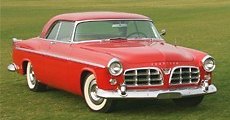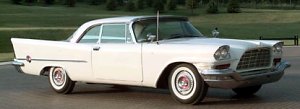 1955 C-300 Chrysler 300 series was the first "muscle car" in American automotive history, although the term "muscle car" would not appear until a decade later. The first generation was introduced in 1955 in the name C-300, whose C stands for Coupe and 300 is the horsepower count. It was the first American car to boost 300 horsepower, and was probably the world's most powerful production car then. C-300 was styled by ex-Studebaker designer Virgil Exner, no wonder its handsome look had strong resemblance to contemporary Studebaker models. Like most other American cars, it was huge (5.6 meters long and 2.0 meters wide) and heavy (nearly 2 tons). However, it got lowered and stiffened suspensions thus it was quite capable on racing tracks even in stock form. Of course, the highlight of the car was the powerful HEMI V8. HEMI was named after its hemispherical combustion chambers. Although this technology had been using in European sports cars for many years, it was the first time an American V8 employ it. Conventional push-rod V8s had their intake and exhaust valves located at the same side. In contrast, a hemispherical combustion chamber placed the intake and exhaust valve at opposite sides facing each other, and the spark plug on the center. This improve breathing and combustion efficiency a lot, resulting in significant power gain. The C-300's HEMI V8 displaced 5.3 litres and produced 300 (gross) horsepower. In terms of horsepower per cubic inch, it was by far higher than conventional V8s. However, it was also very costly to build, as it required two rocker arm shafts each bank. That's why GM and Ford did not follow suit. In Chrysler, for many years the HEMI remained a very exclusive engine for the highest performance models. Chrysler 300 series was the only model employed HEMI V8 as standard. Like the engine, C-300 was a very expensive and exclusive flagship performance model in Chrysler's lineup. It was luxuriously equipped to appeal to wealthy customers. During the 1955 model year, only 1725 cars were built. In this way, it differed from the mass market muscle cars that emerged in the mid-60s. This guarantee its classic car status.  1957 300C Racing success also earned it high respect. It won NASCAR championship immediately and set a new record at 128 mph in the Flying Mile race, confirming its status as the fastest American car then. Nevertheless, C-300 was just the beginning. Each model year Chrysler introduced a new generation. Each had styling and engine modifications, accompanied with a new name. In this way, C-300 evolved to 300B, 300C, 300D… and finally 300L. That is why the series was later known as "300 letter series". Among them, the 300C of 1957 was regarded as the greatest, thanks to a 6.4-litre HEMI good for 375 hp in standard form and 390hp in high compression form. The 300C also introduced a more aggressive design which foresaw the design trend of the early 60s. Unfortunately, because of the high cost, since 1959 Chrysler dropped the HEMI engine from the 300 series. Although the replacement V8s got larger capacity to compensate the lost of efficiency, they never matched the fame set by the early 300 with HEMI engines. After 11 years of production and only 17,000 cars built, the 300 finally came to the end in 1965. Since then Chrysler had no products to succeed this high-end premium performance car. |